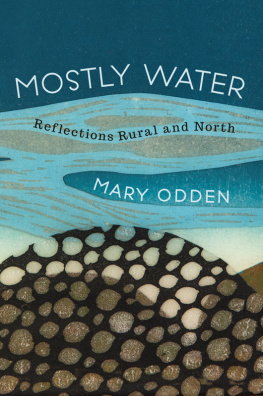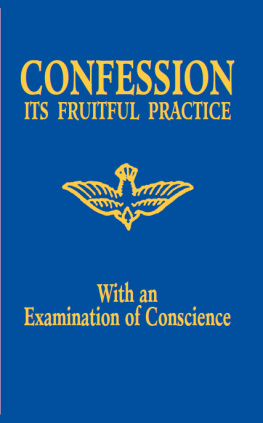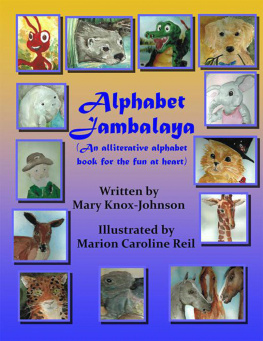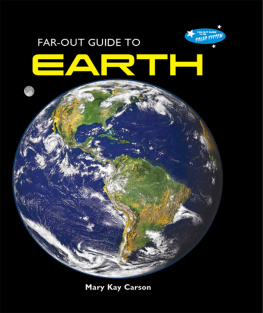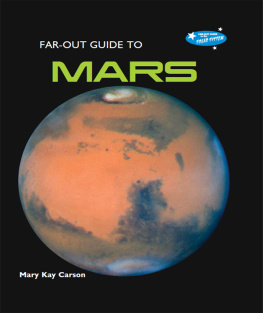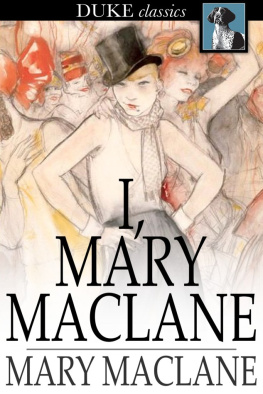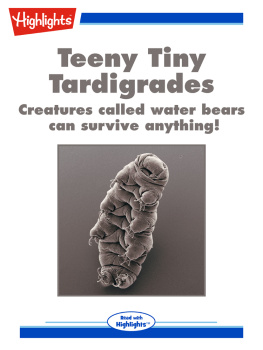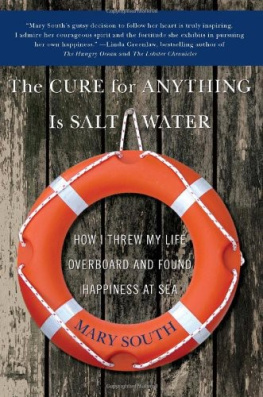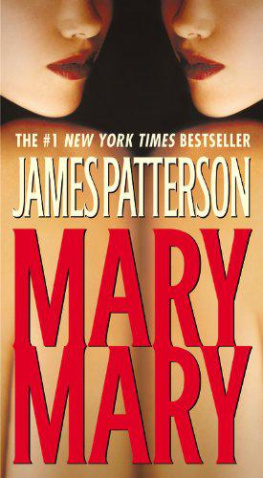Mary Odden - Mostly Water
Here you can read online Mary Odden - Mostly Water full text of the book (entire story) in english for free. Download pdf and epub, get meaning, cover and reviews about this ebook. year: 2020, publisher: Red Hen Press, genre: Non-fiction. Description of the work, (preface) as well as reviews are available. Best literature library LitArk.com created for fans of good reading and offers a wide selection of genres:
Romance novel
Science fiction
Adventure
Detective
Science
History
Home and family
Prose
Art
Politics
Computer
Non-fiction
Religion
Business
Children
Humor
Choose a favorite category and find really read worthwhile books. Enjoy immersion in the world of imagination, feel the emotions of the characters or learn something new for yourself, make an fascinating discovery.
- Book:Mostly Water
- Author:
- Publisher:Red Hen Press
- Genre:
- Year:2020
- Rating:4 / 5
- Favourites:Add to favourites
- Your mark:
- 80
- 1
- 2
- 3
- 4
- 5
Mostly Water: summary, description and annotation
We offer to read an annotation, description, summary or preface (depends on what the author of the book "Mostly Water" wrote himself). If you haven't found the necessary information about the book — write in the comments, we will try to find it.
Mostly Water — read online for free the complete book (whole text) full work
Below is the text of the book, divided by pages. System saving the place of the last page read, allows you to conveniently read the book "Mostly Water" online for free, without having to search again every time where you left off. Put a bookmark, and you can go to the page where you finished reading at any time.
Font size:
Interval:
Bookmark:

MOSTLY WATER
MOSTLY
WATER
Selected
Memoir & Essays
Rural & North

Mary Odden

Mostly Water
Copyright 2020 by Mary Odden
All Rights Reserved
No part of this book may be used or reproduced in any manner whatsoever without the prior written permission of both the publisher and the copyright owner.
Book design by Mark E. Cull
Library of Congress Cataloging-in-Publication Data
Names: Odden, Mary, 1955 author.
Title: Mostly water : selected memoir & essays, rural & north / Mary Odden.
Description: First edition. | Pasadena : Boreal books, [2020]
Identifiers: LCCN 2019042642 | ISBN 9781597099196 (trade paperback) | ISBN 9781597099189 (ebook)
Subjects: LCSH: Odden, Mary, 1955- | Authors, American21st centuryBiography. | AlaskaSocial life and customsAnecdotes. | Country lifeAnecdotes.
Classification: LCC PS3615.D426 A6 2020 | DDC 814/.6dc23
LC record available at https://lccn.loc.gov/2019042642
The National Endowment for the Arts, the Los Angeles County Arts Commission, the Ahmanson Foundation, the Dwight Stuart Youth Fund, the Max Factor Family Foundation, the Pasadena Tournament of Roses Foundation, the Pasadena Arts & Culture Commission and the City of Pasadena Cultural Affairs Division, the City of Los Angeles Department of Cultural Affairs, the Audrey & Sydney Irmas Charitable Foundation, the Kinder Morgan Foundation, the Meta & George Rosenberg Foundation, the Allergan Foundation, the Riordan Foundation, Amazon Literary Partnership, and the Mara W. Breech Foundation partially support Red Hen Press.

First Edition
Published by Boreal Books
an imprint of Red Hen Press
www.borealbooks.org
www.redhen.org
For Jim and Kari
MOSTLY WATER
Looking for the heroic in all the female places
My grandmother Mona was missing an index finger on her left hand because she cut it off with an ax when she was a little girl. The part of her hand that should have been a finger ended at its big round knuckle with not even a scar. That my straight-backed and elegant grandmother with her black shiny shoes and blue-and-white printed jersey dresses had ever been in proximity to firewood was a wonder to me. I was even more impressed after she explained the concept of firewood.
Mona lived in Portland at the end of her life and didnt visit us very often, but the absent finger, which I noticed at about age four, set me on an entirely new course regarding my family. After that, when Mona came to visit, there was a whiff of old cowboy times around the house and enough silences to make her mysterious as well as loved.
Due to some fortunate indiscretion on the part of my grandfather, Harry, I had two grandmothers on my fathers side and cousins in descending ages all over the West. The old hurts had shrunk up to slight pauses in the stories told by the first and second generations, and the meaning of those hesitations was entirely lost upon me in the third. What I knew for sure was that I had two grandmothers who had known horses and wild Indians and cowboys. My other grandmother, Margie, lived close to us for years and was a grandmotherly figure in every way. She grew flowers and sewed aprons and upholstered her own chairs. She baked cookies and muffins. And when she was in her seventies and wed bought an intractable Appaloosa mare named Candy who liked to throw herself over backward to squish the rider, Margie climbed on and taught the mare to behave.
Until I was a teenager, I never learned any names of plants in eastern Oregon where I grew up, except for the few plants that my parents talked me into tending in the garden and the weeds they showed me how to dig out of the yard. As a result, for years the only plants I could identify that grew where we lived were buttonweed and Russian thistle. When I got old enough to read Zane Greys novels about the west at Monas urging, I learned about a few of the desert plants. My favorite Zane Grey heroine was Sego Lily. Lovely words, I thought, and one day I found her namesake. I was riding a horse around the Owyhee Desert margins in spring, probably in dampish and still-green May, when I came up to a flower all by itself on a pale-green stalk. It was surrounded by nothing but the pebbly brown desert soil and a few clumps of sagebrush standing back in admiration. A frail tulip shape, a goblet for an elfeach delicate petal started out pink but reached upward to a nearly transparent white tip. It was like meeting an angel. There was not a doubt in my mind that I was looking at a sego lily, and also that she was a girl.
Some ranch families still needed their horses, but that wasnt our story. We owned a small grocery store, and my father hadnt ridden horses since he was young. In our family, I was the caboose and the only girl. With my grandmothers stories and in the company of a handful of young friends who had horses, I was doomed to be horse-crazy. By the time I was nine, over the worried objections of my mother and the annoyed bemusement of my older brothersall three of them deeply engaged with the second half of the twentieth centurythere was a roan pony in our pasture. Several horses would follow as my dad indulged my interest and explored his own affection for a ranch culture hed never actually had much chance to enjoy when he was living in it.
Dads first order of business was the acquisition of the roan pony, Comet. Comet was rumored to be part Standardbred and part Welsh Pony. Hed sometimes pace, the classy smooth parallel gait of the Standardbred show horse. Dad had asked Rollie McKinley, who knew a lot about horses, to buy me a large pony, so Mr. McKinley brought the sturdy little horse all the way from a sale at Twin Falls, Idaho. He said Comet had been raised by the Blackfoot Indians, a fact that interested me greatly and excused Comets odd color. He was a red roan, a coat color of mixed sorrel and brown and white hairs, but he was also a pinto, with a normal brown eye on the roan side of his head and one blue eye on the white-patched other side. This was very much out of fashion at the time. Now you see pintos all over that country, and even pinto mules, but there were hardly any when I was a kid. None of my friends had one. The country around there was still getting over being a working West and was not yet aware of itself in flashy horses and cowboy poetry.
Comet didnt like men to ride him. Hed evidently had some bad experiences, and he had some health problems too. Hed gotten into too much grain and was slightly foundered, which left his front hooves in terrible shape. He came to us with gigantic rope burns cut into the back of his hocks from being kept on a rope hobble. On someones advice, we rubbed bacon grease into these wounds every day until they closed. He was a gentle soul and allowed us to do this without fidgeting. We trimmed his hooves carefully for months until the spongy and sore red areas from the foundering worked themselves out. He was docile when I rode, but he was feisty with Dad and threw my brothers off his back at any chance they gave him. To tease me, they called him Vomit. One day my middle brother Cliff was going to ride the kinks out of him for me, but as soon as he swung onto Comets bare back, Comet took off down the hill toward the Snake River at a run. About eighty yards into the ride, Cliff didnt make the same sudden ninety-degree left turn as the agile little horse. Comet ended up at Mrs. Williamss house, and Cliff ended up in the ditch. After a while Cliff came back up the hill leading the horse. Giving me a leg up, he delivered a too-hard push that sent me clear over Comets back and piled me up in the gravel on the other side. Whaddya do that for? I asked him.
Font size:
Interval:
Bookmark:
Similar books «Mostly Water»
Look at similar books to Mostly Water. We have selected literature similar in name and meaning in the hope of providing readers with more options to find new, interesting, not yet read works.
Discussion, reviews of the book Mostly Water and just readers' own opinions. Leave your comments, write what you think about the work, its meaning or the main characters. Specify what exactly you liked and what you didn't like, and why you think so.

